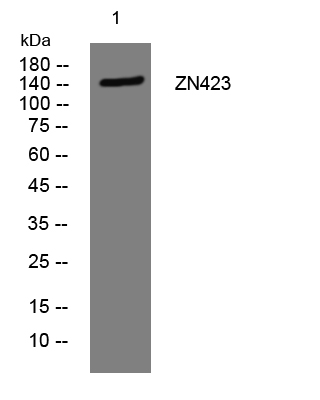ZN423 rabbit pAb
- Catalog No.:YT6974
- Applications:WB
- Reactivity:Human;Mouse;Rat
- Target:
- ZN423
- Gene Name:
- ZNF423 KIAA0760 NPHP14 OAZ
- Protein Name:
- ZN423
- Human Gene Id:
- 23090
- Human Swiss Prot No:
- Q2M1K9
- Mouse Gene Id:
- 94187
- Mouse Swiss Prot No:
- Q80TS5
- Rat Gene Id:
- 94188
- Rat Swiss Prot No:
- O08961
- Immunogen:
- Synthesized peptide derived from human ZN423 AA range: 848-898
- Specificity:
- This antibody detects endogenous levels of ZN423 at Human/Mouse/Rat
- Formulation:
- Liquid in PBS containing 50% glycerol, 0.5% BSA and 0.02% sodium azide.
- Source:
- Polyclonal, Rabbit,IgG
- Dilution:
- WB 1:500-2000
- Purification:
- The antibody was affinity-purified from rabbit antiserum by affinity-chromatography using epitope-specific immunogen.
- Concentration:
- 1 mg/ml
- Storage Stability:
- -15°C to -25°C/1 year(Do not lower than -25°C)
- Molecular Weight(Da):
- 141kD
- Background:
- The protein encoded by this gene is a nuclear protein that belongs to the family of Kruppel-like C2H2 zinc finger proteins. It functions as a DNA-binding transcription factor by using distinct zinc fingers in different signaling pathways. Thus, it is thought that this gene may have multiple roles in signal transduction during development. Mutations in this gene are associated with nephronophthisis-14 and Joubert syndrome-19. Alternatively spliced transcript variants encoding different isoforms have been found for this gene. [provided by RefSeq, Oct 2012],
- Function:
- domain:Uses different DNA- and protein-binding zinc fingers to regulate the distinct BMP-Smad and Olf signaling pathways. C2H2-type zinc fingers 14-19 mediate the interaction with SMAD1 and SMAD4, while zinc fingers 28-30 mediate the interaction with EBF1. zinc fingers 2-8 bind the 5'-CCGCCC-3' DNA sequence in concert with EBF1, while zinc fingers 9-13 bind BMP target gene promoters in concert with SMADs.,function:Transcription factor that can both act as an activator or a repressor depending on the context. Plays a central role in BMP signaling and olfactory neurogenesis. Associates with SMADs in response to BMP2 leading to activate transcription of BMP target genes. Acts as a transcriptional repressor via its interaction with EBF1, a transcription factor involved in terminal olfactory receptor neurons differentiation; this interaction preventing EBF1 to bind DNA and activate olfactory-
- Subcellular Location:
- Nucleus .
- Expression:
- Expressed in brain, lung, skeletal muscle, heart, pancreas and kidney but not liver or placenta. Also expressed in aorta, ovary, pituitary, small intestine, fetal brain, fetal kidney and, within the adult brain, in the substantia nigra, medulla, amygdala, thalamus and cerebellum.
- June 19-2018
- WESTERN IMMUNOBLOTTING PROTOCOL
- June 19-2018
- IMMUNOHISTOCHEMISTRY-PARAFFIN PROTOCOL
- June 19-2018
- IMMUNOFLUORESCENCE PROTOCOL
- September 08-2020
- FLOW-CYTOMEYRT-PROTOCOL
- May 20-2022
- Cell-Based ELISA│解您多样本WB检测之困扰
- July 13-2018
- CELL-BASED-ELISA-PROTOCOL-FOR-ACETYL-PROTEIN
- July 13-2018
- CELL-BASED-ELISA-PROTOCOL-FOR-PHOSPHO-PROTEIN
- July 13-2018
- Antibody-FAQs
- Products Images

- Western blot analysis of lysates from DU145 cells, primary antibody was diluted at 1:1000, 4°over night



